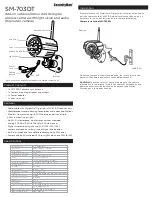
Chapter 4
Capturing Images
11
Setting the aperture diaphragm
Adjust the aperture diaphragm in the following way according to the illumination type.
For diascopic illumination:
Generally, the numeric value of the condenser aperture diaphragm should be adjusted to approximately 70% to 80%
of the numerical aperture (NA) of the objective.
For episcopic illumination:
Generally, the aperture diaphragm should be adjusted to approximately 70% to 80% of the size of the pupil of the
objective that can be seen by removing the eyepiece and looking into the eyepiece tube.
Adjustment of aperture diaphragm
For details of the aperture diaphragm adjustment, refer to the instruction manual of your microscope.
For capturing images that have greater depth of focus, close down the aperture diaphragm. Note that
closing down the aperture may limit the performance of the objective.
Depth of focus
“Depth of focus” refers to the in-focus range along the direction vertical to the specimen surface. While
reducing the aperture diaphragm extends the depth of focus, it reduces resolution to some extent on the
other hand. Adjust the aperture diaphragm in accordance with your needs.
Adjusting the focus on the subject
Adjust the focus of the microscope so that the image can be clearly seen on the monitor.
Adjusting the focus on a dark subject
If the subject is dark making the exposure time long and the focusing difficult, we recommend that you use
the [DF/FL] scene mode. For how you operate the [DF/FL] scene mode, refer to the instruction manual for
the NIS-Elements.
Adjusting the illumination
When capturing a color image, the color reproducibility of the image depends on the lamp voltage.
When a halogen lamp is used as the light source, increasing the lamp voltage produces a bluish light, while
decreasing the lamp voltage produces a reddish light.
Except in cases where it is specifically necessary to adjust the tone, the voltage should be set to the proper level for
micrography, which depends on the microscope being used. Since this level varies by type of microscope, refer to the
instruction manual of your microscope.
Note: If the lamp voltage changes, adjust the white balance once again.
White balance during observation with the microscope
Consider the following when you adjust the white balance while viewing on the microscope.
When using diascopic illumination for microphotography, adjust the white balance while you are
photographing a transparent part of the preparation.
When using episcopic illumination for microphotography or using a lens, adjust the white balance using a
white subject.
For fluorescent photographing, we recommend that the white balance be adjusted under normal light
conditions before photographing. If the screen is excessively dark or bright, adjust the light intensity of the
light source or the iris diaphragm, or use an ND filter to obtain the appropriate white balance.
Selecting an operation mode
Multiple operation modes are available for image capture using the product, including All pixels, 3 x 3 pixels average,
and ROI modes. Refer to the table below to select an operation mode optimum for your subject, application, etc.,
Operation mode
Suitable application
All pixels
High resolution, wide FOV image capture
3 x 3 pixels average
Wide FOV, high frame rate image capture
ROI
Narrow FOV, high frame rate image capture
For more information on pixel count and frame rate for each operation mode, see “Chapter 7 Major Specifications.”
For information on settings of operation modes, refer to the instruction manual of the NIS-Elements.
Summary of Contents for DS-Qi2
Page 2: ......
Page 10: ...Safety Precautions viii ...













































